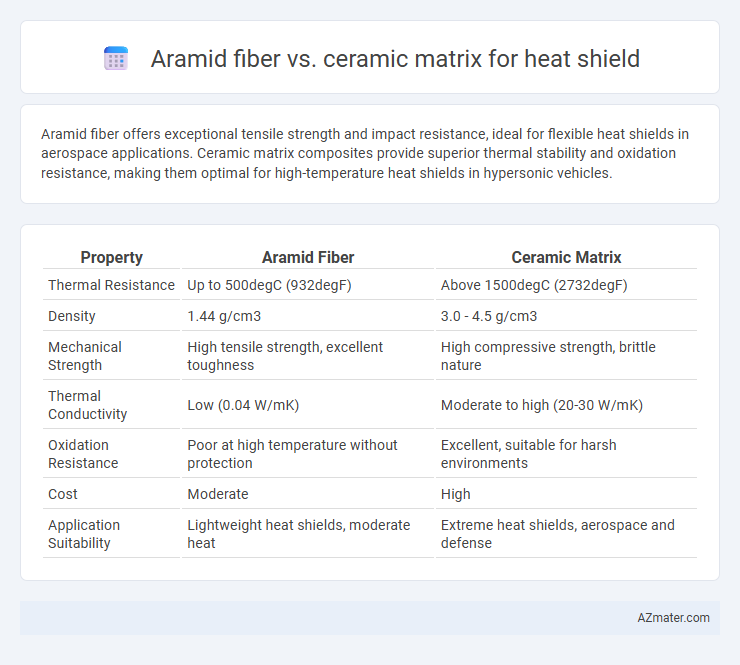Aramid fiber offers exceptional tensile strength and impact resistance, ideal for flexible heat shields in aerospace applications. Ceramic matrix composites provide superior thermal stability and oxidation resistance, making them optimal for high-temperature heat shields in hypersonic vehicles.
Table of Comparison
| Property | Aramid Fiber | Ceramic Matrix |
|---|---|---|
| Thermal Resistance | Up to 500degC (932degF) | Above 1500degC (2732degF) |
| Density | 1.44 g/cm3 | 3.0 - 4.5 g/cm3 |
| Mechanical Strength | High tensile strength, excellent toughness | High compressive strength, brittle nature |
| Thermal Conductivity | Low (0.04 W/mK) | Moderate to high (20-30 W/mK) |
| Oxidation Resistance | Poor at high temperature without protection | Excellent, suitable for harsh environments |
| Cost | Moderate | High |
| Application Suitability | Lightweight heat shields, moderate heat | Extreme heat shields, aerospace and defense |
Introduction to Heat Shield Materials
Heat shield materials require exceptional thermal resistance and mechanical strength to protect aerospace structures during extreme re-entry temperatures. Aramid fiber offers lightweight durability and high tensile strength, making it effective for moderate heat exposure, while ceramic matrix composites deliver superior heat tolerance exceeding 1500degC with excellent thermal shock resistance. Choosing between aramid fiber and ceramic matrix depends on specific mission requirements, including temperature ranges, weight constraints, and impact resistance.
Overview of Aramid Fiber Properties
Aramid fibers exhibit exceptional tensile strength, high thermal stability up to approximately 500degC, and excellent impact resistance, making them ideal for lightweight heat shield applications. Their low density enhances thermal insulation while maintaining structural integrity under moderate heat exposure. Unlike ceramic matrices, aramid fibers offer superior flexibility and resistance to cracking but are less effective at withstanding extreme temperatures above 1000degC.
Understanding Ceramic Matrix Composites
Ceramic matrix composites (CMCs) offer superior thermal stability and resistance to oxidation compared to aramid fibers, making them ideal for heat shield applications exposed to extreme temperatures exceeding 1200degC. The microstructure of CMCs, typically silicon carbide or alumina matrices reinforced with ceramic fibers, provides enhanced toughness and crack resistance, which aramid fibers lack due to their organic polymer nature. These properties enable ceramic matrix composites to maintain structural integrity and thermal protection in aerospace and industrial heat shield environments where aramid fibers would degrade.
Thermal Resistance: Aramid vs Ceramic Matrix
Ceramic matrix composites exhibit superior thermal resistance compared to aramid fibers, withstanding extreme temperatures exceeding 1,200degC without degradation. Aramid fibers, such as Kevlar, typically endure temperatures up to approximately 500degC before thermal weakening occurs. The inherent high melting point and oxidation resistance of ceramic matrices ensure enhanced durability in high-heat aerospace and industrial heat shield applications.
Durability and Mechanical Strength Comparison
Aramid fiber exhibits high tensile strength and excellent impact resistance, making it durable under dynamic mechanical loads, but its performance degrades significantly at temperatures above 400degC. Ceramic matrix composites maintain superior mechanical strength and structural integrity at extreme temperatures exceeding 1000degC, offering enhanced durability for high-heat shield applications. The trade-off between aramid fiber's flexibility and ceramics' thermal stability defines material selection for heat shields requiring both mechanical robustness and prolonged high-temperature exposure.
Weight and Flexibility Factors
Aramid fiber heat shields offer significantly lower weight compared to ceramic matrix composites, making them ideal for applications requiring enhanced maneuverability and reduced mass. The inherent flexibility of aramid fibers allows for better conformability to complex shapes, improving overall thermal protection coverage. Ceramic matrix composites provide superior thermal resistance but are generally heavier and more rigid, limiting their adaptability in weight-sensitive and flexible heat shield designs.
Cost and Manufacturing Considerations
Aramid fiber composites offer lower raw material costs and simpler manufacturing processes such as weaving and resin impregnation, making them more cost-effective for heat shield production compared to ceramic matrix composites. Ceramic matrix heat shields require advanced fabrication techniques like chemical vapor infiltration or hot pressing, which significantly increase manufacturing complexity and expenses. While ceramic matrices provide superior thermal resistance, their higher production costs and longer cycle times influence budget-conscious design decisions.
Application Suitability in Aerospace and Automotive
Aramid fiber offers exceptional tensile strength, flexibility, and lightweight properties, making it ideal for aerospace components requiring impact resistance and thermal protection in high-temperature environments below 500degC. Ceramic matrix composites excel in aerospace and automotive heat shields operating above 1000degC due to their superior thermal stability, oxidation resistance, and structural integrity under extreme heat conditions. Choosing between aramid fiber and ceramic matrix depends on specific temperature thresholds and mechanical stress demands in aerospace thermal protection systems and automotive exhaust or brake components.
Environmental Resistance and Longevity
Aramid fiber heat shields demonstrate superior flexibility and impact resistance but tend to degrade faster under prolonged high-temperature exposure and oxidative environments compared to ceramic matrix composites (CMCs). Ceramic matrix heat shields offer exceptional thermal stability, oxidation resistance, and structural integrity at temperatures exceeding 1400degC, leading to enhanced longevity in harsh aerospace and automotive applications. Their inherent resistance to thermal shock and corrosive environments significantly extends service life compared to organic-based aramid fibers, making CMCs the preferred choice for extreme environmental conditions.
Choosing the Right Material: Key Considerations
When selecting between aramid fiber and ceramic matrix for heat shields, the decision hinges on factors such as thermal resistance, mechanical strength, and weight. Ceramic matrix composites offer superior high-temperature tolerance above 1200degC and excellent oxidation resistance, making them ideal for extreme heat environments. Aramid fibers provide lightweight structural support and impact resistance but have lower maximum service temperatures, typically below 500degC, which limits their use in intense thermal scenarios.

Infographic: Aramid fiber vs Ceramic matrix for Heat shield
 azmater.com
azmater.com